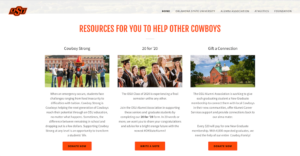The world has been flipped upside down in the last few weeks. Campuses, typically buzzing as spring arrives, are now empty. Giving days have been postponed, mass solicitations canceled, and advancement teams are building day-to-day routines from scratch in this “new normal.”
As we figure out how to handle fundraising and engagement during the COVID-19 pandemic, we’ve put together a guide for the annual fund on how to move forward toward the end of this unusual fiscal year.
Collect and share impact stories
Think about the student-focused stories you’ve shared in the past, especially those around res life, the food pantry, student support, research, or the medical center. Pick topics that are on the forefront of everyone’s mind, then build a list or story bank of those articles and videos to share with your entire team. These stories are perfect material for both stewardship and future solicitations, so work with your digital team to share the content online now to build awareness and engagement.
Your organization is also doing great things in real-time. We’re constantly seeing posts of colleges donating medical supplies and PPE gear to local hospitals, providing meals for medical workers, expanding the food pantry to feed students who can’t return home, or converting dorms to homeless shelters.
If you’re not already following your institution’s social channels, you need to start paying attention daily. Each of those stories is an opportunity to demonstrate the instant impact of unrestricted giving with the right audience.
Turn your giving page or advancement homepage into a resource hub and showcase how your school is meeting the needs of students, alumni, and the community. We love Oklahoma State’s version of this, which came together in just a couple of days.
Invest in stewardship
On a recent live Q&A, Lynne Wester shared a stat that jumped out. In the 2008 financial crisis, teams that prioritized stewardship increased overall fundraising.
“Stewardship and donor relations needs to be forefront,” Lynne said, “After the 2008 crash, advancement shops that invested in donor relations professionals were up 19% in total fundraising, while those who invested only in frontline fundraisers were down 9%. You can’t just ask. You have to nurture relationships, check in with donors, ask about health and well-being… We have to turn into what fundraising really is: a relationship business, not a transactional one.”
If you’ve followed the first step and created a story bank, then share those stories with your current donors. Thank them for their support, show them how the funds are being put to use during this crisis, and then thank them again for good measure!
Take your stewardship segmentation to the next level by using donors’ interests and sharing stories that align. EverTrue lets you identify constituents interested in certain topics (say “medical research”) and build lists in seconds. You can also see which donors are interacting with COVID-19 or student support-related Facebook posts and thank them for their generosity in a really personal way.
Invest in one-on-one outreach
Speaking of personal… it’s time to be more human than ever. A short personal email, video message, or phone call goes a long way. In the same way we’re encouraging gift officers to increase activity and check-in with every assigned prospect, annual giving teams should be having as many one-on-one conversations as possible.
But since the annual fund talks to thousands — or even tens of thousands — of donors, you’re going to have to do some prioritization first.
Start with your fundraising volunteers. Shoot them a note, say thanks, and ask how they’re doing. Pass along a story or two from campus to let them know how the institution has stepped up during the crisis. Host a Q&A with leadership that they can attend on Zoom or Facebook. Offer to be a resource — especially if they’re concerned with losing their job.
Then exend that same experience to your loyal donors. Look at the ones with 3, 5, 10, 15 years of consecutive giving or more. Reach out to those with recurring gifts (since they don’t typically receive solicitations, they can actually hear news from campus less than non-donors). Connect with leadership giving society members, donors who increased their giving this year, or even ones who gave for the first time. Everyone needs to see a friendly face right now — and you can be that person for one of your donors.
If you have EverTrue, use shared lists and comments to coordinate outreach among your team. Or set up custom portfolios with hundreds of assigned prospects to create simple stewardship workflows for your team.
The right technology (Thankview for video or Yesware for email, for example) makes it easy to create one message and send it to dozens of people, yet still feel personal. This is the time to try out something new.
Thinking about launching a digital gift officer program? We’ve got a playbook for that.
Leadership giving pipeline
With most institutions suspending broad solicitations on a temporary basis, this is an opportunity to dig into the data and create lists for growing leadership donors and building future major gift pipeline.
Look for unassigned donors who have high net worth, live in wealthy neighborhoods, or have large capacity ratings but are giving at levels that don’t trigger a personal thank-you. Then go ahead and thank them yourself (or pass the list to your leadership giving team). If you need to narrow down the list, start with those who are interacting with your posts on Facebook. Engaged alumni are 3.4x as likely to be donors.
Here are more ideas for creating better relationships with leadership giving prospects.
Transition to “normal” fundraising
We can’t hold off on solicitations forever. At some point, every single advancement team will resume sending annual fund appeals. But the ones who do it best will connect directly to the interests and engagement levels of their audience.
Your message has to be completely focused on your potential donors and their interests — now more than ever. So invest more time into refining segmentation and connecting with the right potential donors.
As you transition back into sending solicitations, start with your most-likely-to-give audiences. Who gives in the last quarter of the year, every year? Who’s a LYBUNT and highly engaged on Facebook? Who has a known interest in student support or residential life? Who’s attending your virtual events? Who’s actively asking how they can help?
This is not the time to solicit by class year or because an alum graduated from a particular school or college. The more personal the ask feels, the more likely it will be well-received.
As a lot of organizations think about the next email appeal, mail piece, or reschedule a giving day to coincide with the May 5 #GivingTuesdayNow initiative, put the donor first with every appeal. Deliver stories that they care about. Show impact. Test segmentation. And be ready to respond, personally, to every response you get in return.
Tackle some big projects
We talked with Heather Kopec, Director of Annual Giving, at Virginia Tech. Her team had to pull the plug on its giving day, which was a big blow to its original fundraising plan.
They’re using this work-from-home time to think about projects that they can launch early in the next fiscal year. They’re designing a better, more exciting monthly giving program for Hokie alumni to promote recurring gifts. And they’re looking into new ways to celebrate giving milestones when a donor hits their 5, 10, 15-year anniversary and beyond.
If your plans have been canceled and your appeal schedule has been pushed for the next few weeks, start thinking about what you and your team can be doing to hit the ground running once we beat COVID-19 for good.
Here’s EverTrue’s take on the novel coronavirus pandemic and its impact on advancement: We don’t have all the answers, but we’re going to learn from each other and share best practices for remote fundraising, working from home, and handling uncertainty. Bookmark this page and subscribe for ongoing updates.

